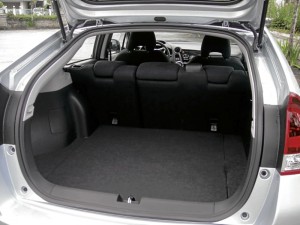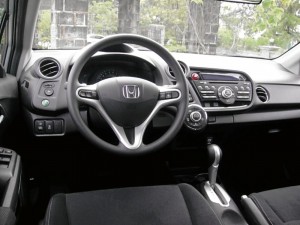Looking forward to Honda’s Hybrid Insight
There’s a new hybrid car in town and it’s a Honda. If you happen to see a car on the road that looks like the Honda Civic up front but has a longer, taller “humpback” body design, that’s the 2013 Honda Insight. Blue-tinted chrome bezels on the projector-type headlights and LED tail lights, a rear spoiler with LED brake light and 16-inch alloy wheels further distinguish Honda’s hybrid model from the Civic.
Unlike the first-generation two-seater Insight which was launched in 2009, the 2013 model, which is essentially the same as the 2012 iteration, is a 4-door hatchback and can seat five. From day one, the Insight was touted as the lowest-priced hybrid car on the market. Like the first Insight, the current model is powered by Honda’s Integrated Motor Assist (IMA) hybrid system that pairs Honda’s 1.3-liter i-VTEC 4-cylinder SOHC 8 valve gasoline engine with an electric motor and nickel-metal hydride battery pack for a total peak output of 99 HP/ 5,800 rpm and 17 Nm max torque/1,000-1,700 rpm. A 5-speed CVT (continuously variable transmission) directs the powerplant’s output to the front wheels.
But unlike the Toyota Prius’ Hybrid Synergy Drive, the Insight has a mild hybrid setup whereby the gas engine is assisted by the electric motor rather than working tandem. There is no transition between the electric and gas modes since the powertrain doesn’t have a dedicated electric-only mode and the electric motor works only to assist the gas engine when more power is needed, as when the car is overtaking in traffic or climbing hills. On the other hand, in fully hybrid powertrains like the Prius, the electric motor takes over completely when the car is driven at low speeds.
MILD HYBRID. Because the Insight is a mild hybrid, driving it feels more like driving a normal gasoline-only car than the Prius. In fact, when I first took the wheel of the Insight I was pleasantly surprised by its responsive steering and agile handling, akin to that of a spunky nonhybrid ride. The Insight’s slightly fun-to-drive nature can be traced to the electric-power-assisted rack and pinion steering that provides a predictable and linear steering feel and the firm, relatively sporty suspension (MacPherson strut in front, double wishbone at the rear), not to mention the paddle shifters. But it doesn’t match the athletic driving dynamics of fuel-efficient, nonhybrid small cars like the Mazda2 or Ford Fiesta. Also, people used to a cushy, comfy ride quality may find the Insight’s firm suspension rather unrefined and harsh over rough pavement.
Weighing 400 kg heavier than the original two-seater model, the current Insight accelerates slowly, requiring more than 10 seconds to hit 100 kph from standstill. But then the Insight’s main reason for being is not high performance but fuel economy, and this is where it shines despite the limitations of its mild hybrid drive system. The United States Environmental Protection Agency (EPA) places the Insight’s mileage at 17 km/liter in the city and 18.5 km/liter on the highway, which is good enough for an Integrated Motor Assist powertrain.
BLUE TO GREEN. The cockpit of the Insight is designed to encourage fuel-efficient driving with a Multiplex Meter instrument cluster plus background lighting within the speedometer turning green to reflect overall efficient driving and blue when it’s inefficient. The Stop/Start system saves fuel by automatically turning the engine off when the car stops and on when you step on the gas pedal. Pushing the ECON button on the dashboard modifies throttle control, CVT operation, idle-stop duration and air conditioner operation to minimize energy use and increase fuel efficiency.

Broad, flat cargo space increases to 31.6 cubic feet with rear seats folded. PHOTOS BY AIDA SEVILLA-MENDOZA
The speed-sensitive audio system consists of a single CD in-dash with MP3 and WMA playback capability, USB connection and exterior auxiliary jack, four speakers and two tweeters.
PRACTICAL. The second-generation Insight is much more practical than the original because its four-door hatchback design increases cabin and cargo space. The front seats are comfy and spacious with plenty of headroom and legroom. The split-folding rear seat, however, offers less legroom and headroom due to the rakishly sloping hatchback roofline. In terms of cargo hold, the 2013 Insight is best in class with 15.9 cubic feet of broad, flat floor space with all the seats in use expanding to 31.6 cubic feet when the rear seat is folded. Lots of room for golf bags, sports gear, luggage and groceries.
The Insight doesn’t need rear parking sensors or a backup camera because rearward visibility from the driver’s seat is excellent, thanks to the pillarless rear quarter windows and second-row glass windshield at the back. Being imported CBU (completely built unit), the Insight has a full suite of safety features including six airbags, knee bolsters for driver and front passenger, Vehicle Stability Assist, ABS with EBD and brake assist, creep-aid system and security system with alarm and immobilizer.
But don’t ask about the Insight’s retail price. Honda Cars Philippines Inc. isn’t selling it yet pending the approval of a tax incentive law that will enable them to offer this hybrid at a reasonable and attractive price.
















